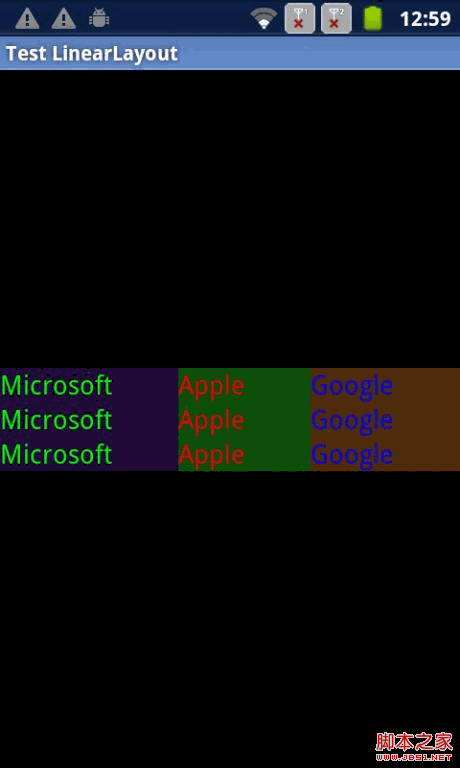在android的api中可以发现有很多用整数集来作为参数的地方,先来看一下实例。
linearlayout是大家所熟知的一个ui基本元素,它里面有一个方向的属性,可以通过以下方法来设置:
复制代码 代码如下:
linearlayout.setorientation(int);
使用的时候,通常都是这样:
复制代码 代码如下:
linearlayout.setorientation(linearlayout.horizontal);
linearlayout.setorientation(linearlayout.vertical);
但也可以这样使用:
复制代码 代码如下:
linearlayout.setorientation(0); // linearlayout.horizontal = 0
linearlayout.setorientation(1); // linearlayout.vertical = 0x01
甚至可以这样:
复制代码 代码如下:
linearlayout.setorientation(integer.max_value);
linearlayout.setorientation(integer.min_value);
linearlayout.setorientation(2012);
因为方法setorientation接收的参数是一个整数,所以你可以传任意合法的整数---至少这在编译时不会有任何问题。它只会在运行时可能引发问题,但如你所知,开发者只关注程序能否编译成功,至于运行时,那是用户关心的事儿,因为开发者不一定使用他们所开发出的程序。
除了这个例子,在android的api中到处可以看到这种api,比如设置view的可见性,设置wifi状态等等。都是定义了整数集,然后用整数来做为参数,并寄希望开发者能传递整数集中定义的常量来作为参数。但如你所知,并不是每个人都那么的守规矩,如果每个人都能遵守规则,这个世界就真的和谐了,蛋扯远了。
因为开发者通常只能关注编译,所以如果能把这个规则应用在编译时,那么就会大大减少出错的可能。有兴趣的朋友可以去试试看,给这些接收整数参数的方法传一些“平常”的数值,比如2012,integer.max_value,integer.min_value等等,看会出现什么状况。
另外,如果开发者传递与常量定义一致的整数值,虽然编译运行都不会有错,但代码的可读性会大大的降低,比如:
复制代码 代码如下:
linearlayout.setorientation(0);
linearlayout.setorientation(1);
这完全没有错,但是代码的阅读者和维护者通常都会蛋疼的。
当然,android自身还是有保护措施的,如果对api传递不合法参数,不会造成其他影响,只是设置不能生效,但api会使用默认值,因为对于每个内置参数,都有相应的默认值。如linearlayout的orientation,默认值就是linearlayout.horizontal,所以如果对setorientation()传入非法值,linearlayout会保持水平排列,无其他影响。后面有个对linearlayout的orientation做的试验。
另外,如果在layout xml文件中设置这些属性就不会有些问题,如:
复制代码 代码如下:
<linearlayout
android:orientation="vertical"
android:gravity="center">
因为xml布局会在编译时被处理,如果有非法的值,会有编译错误的。我想这也就是android特别鼓励开发者用xml来制作所有的布局的一个原因吧。实例,三个没有设置指向的线性布局,默认是水平放置,在代码中设置了几个离谱的值,发现它们还是水平的,也就是说设置离谱的值不会出错,但也不起作用:运行结果如下:

代码如下:
复制代码 代码如下:
<?xml version="1.0" encoding="utf-8"?>
<linearlayout xmlns:android="http://schemas.android.com/apk/res/android"
android:orientation="vertical"
android:layout_width="fill_parent"
android:layout_height="fill_parent"
android:gravity="center"
>
<linearlayout
android:id="@+id/linearlayout_test_1"
android:layout_width="fill_parent"
android:layout_height="wrap_content">
<textview
android:layout_width="wrap_content"
android:layout_height="wrap_content"
android:textcolor="#ff00ff00"
android:background="#aa331155"
android:layout_weight="1"
android:textsize="18sp"
android:text="microsoft"
/>
<textview
android:layout_width="wrap_content"
android:layout_height="wrap_content"
android:textcolor="#ffff0000"
android:background="#aa117711"
android:layout_weight="1"
android:textsize="18sp"
android:text="apple"
/>
<textview
android:layout_width="wrap_content"
android:layout_height="wrap_content"
android:textcolor="#ff0000ff"
android:background="#aa774411"
android:layout_weight="1"
android:textsize="18sp"
android:text="google"
/>
</linearlayout>
<linearlayout
android:id="@+id/linearlayout_test_2"
android:layout_width="fill_parent"
android:layout_height="wrap_content">
<textview
android:layout_width="wrap_content"
android:layout_height="wrap_content"
android:textcolor="#ff00ff00"
android:background="#aa331155"
android:layout_weight="1"
android:textsize="18sp"
android:text="microsoft"
/>
<textview
android:layout_width="wrap_content"
android:layout_height="wrap_content"
android:textcolor="#ffff0000"
android:background="#aa117711"
android:layout_weight="1"
android:textsize="18sp"
android:text="apple"
/>
<textview
android:layout_width="wrap_content"
android:layout_height="wrap_content"
android:textcolor="#ff0000ff"
android:background="#aa774411"
android:layout_weight="1"
android:textsize="18sp"
android:text="google"
/>
</linearlayout>
<linearlayout
android:id="@+id/linearlayout_test_3"
android:layout_width="fill_parent"
android:layout_height="wrap_content">
<textview
android:layout_width="wrap_content"
android:layout_height="wrap_content"
android:textcolor="#ff00ff00"
android:background="#aa331155"
android:layout_weight="1"
android:textsize="18sp"
android:text="microsoft"
/>
<textview
android:layout_width="wrap_content"
android:layout_height="wrap_content"
android:textcolor="#ffff0000"
android:background="#aa117711"
android:layout_weight="1"
android:textsize="18sp"
android:text="apple"
/>
<textview
android:layout_width="wrap_content"
android:layout_height="wrap_content"
android:textcolor="#ff0000ff"
android:background="#aa774411"
android:layout_weight="1"
android:textsize="18sp"
android:text="google"
/>
</linearlayout>
</linearlayout>
和:
复制代码 代码如下:
package com.android.explorer;
import android.app.activity;
import android.os.bundle;
import android.widget.linearlayout;
public class linearlayouttest extends activity {
@override
public void oncreate(bundle savedinstancestate) {
super.oncreate(savedinstancestate);
setcontentview(r.layout.linearlayout_test);
linearlayout one = (linearlayout) findviewbyid(r.id.linearlayout_test_1);
one.setorientation(2012);
linearlayout two = (linearlayout) findviewbyid(r.id.linearlayout_test_2);
two.setorientation(integer.max_value);
linearlayout three = (linearlayout) findviewbyid(r.id.linearlayout_test_3);
three.setorientation(integer.min_value);
}
}
用enum代替整数集
其实很简单,用enum(枚举)就可以很方便的解决这个问题,使用起来也不比定义整数集繁琐,同样的可读。另外的优点就是,它的封装更好,最重要的是它会在编译时被检查。因为java是一种strong type,也就是说在编译时,编译器会对所有原型类型和参数类型进行检查,如果类型不对,并且没有强制转型的,就会报出编译错误,当然编译器所支持的自动转型除外。比如一个需要int,而传的参数是long,虽然都差不多,没有溢出等,但还是会有编译错误。
所以,如果linearlayout使用enum,就像这样定义:
复制代码 代码如下:
public class linearlayout extends viewgroup {
private orientation morientation;
public enum orientation {
horizontal, vertical
};
public void setorientation(orientation dir) {
morientation = dir;
}
}
然后这样使用:
复制代码 代码如下:
import android.widget.linearlayout;
linearlayout.setorientation(orientation.horizontal);
linearlayout.setorientation(orientation.vertical);
那么,开发者就不会用错了,因为首先,它看到setorientation所需要的参数是一个orientation的枚举类型,就会自然的传送orientation中定义的类型;另外,如果传其他的值,比如0或者1,编译器也不会答应的。
可悲的是android中几乎所有的api都是以整数集的方式来定义的,所以就要时刻提醒自己和组里的人,一定要传所定义的整数集中的常量。
那么我们能做的,除了要传整数集中定义的常量,对于那些以整数集方式定义的api,以外。更重要的是当自己定义接口的时候,尽量用enum而不要使用整数集。
还有一点需要注意的是,对于某些弱类型语言,也就是说在编译时不会对类型做特别细致的检查,比如c++,c等,那么即使使用了enum,也不一定安全,因为对于c++和c来讲enum中的常量与整数常量完全一样,连编译器都分不清。所以,对于这类语言,只能寄希望于开发者了。
后记:
写完这篇,让我想起了另外一些与参数定义相关的问题,比如布尔型参数也不是一个很好的设计,因为使用者很难到底应该传true还是传false,特别是当方法名字不能体现boolean参数作用时和文档不够清楚的时候。如果只有一个参数还好,根据方法名字和常识都能知道,比如:
复制代码 代码如下:
button.setenabled(true); // enable the button
button.setenabled(false); // disable the button
但对于某些情况,当方法的名字不能体现boolean参数的作用时,或是多于一个参数时,而方法的主要目的又不能体现boolean参数的作用时,就很不清楚,比如:
复制代码 代码如下:
// com/android/mms/data/contactlist.java
public string[] getnumbers(boolean);
您能猜出来这个boolean变量是决定是否要为彩信对联系人做特殊的处理吗?您在使用这个api的时候能很快知道该传true还是该传false吗?当读到这些语句的时候:
复制代码 代码如下:
string[] mms = getnumbers(true);
string[] sms = getnumbers(false);
您能知道true和false的含义与作用吗?至少我看到这样的代码时,如果不去跟踪它的实现,是猜不出来的。
但现实的问题是,api通常又需要从调用者那里得到做还是不做的决定。一个可行的途径是用方法来封装和隐藏,比如:
复制代码 代码如下:
button.setenabled(true); // enable the button
button.setenabled(false); // disable the button
可以改成:
复制代码 代码如下:
button.enable();
button.disable();
这是简单的情况,对于稍复杂的情况,比如后一个例子,可以添加另外的接口,而不是用重载方法,但内部的实现,可能还是需要重载,但是这就把问题缩小了,起码对使用者来说是隐藏的:
复制代码 代码如下:
// com/android/mms/data/contactlist.java
public string[] getnumbersforsms();
public string[] getnumbersformms();
这样一来,对外来讲就是良好的封装。内部实现可能还是需要一个类似这样的私有方法:
复制代码 代码如下:
// com/android/mms/data/contactlist.java
public string[] getnumbersforsms() {
return getnumbers(false);
}
public string[] getnumbersformms() {
return getnumbers(true);
}
private string[] getnumbers(boolean) {
// implementation
}
但至少把问题缩小化了,也可以加上注释来说明。就不必导致使用者来猜方法的用法和含义了。














